The Treasures of York
by Pearl Harris
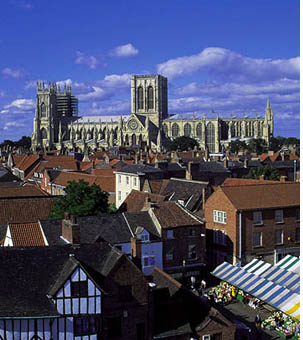 "Live the History", the slogan of York Tourism, puts into a nutshell what this great city is all about. The history of York, capital of the North, is the history of England.
"Live the History", the slogan of York Tourism, puts into a nutshell what this great city is all about. The history of York, capital of the North, is the history of England.
The City of York is the culmination of a 2000-year fusion of Roman, Saxon, Viking and Victorian civilizations. Its history begins with the Roman 9th Legion, who built a fortress here in AD 71 during its campaign against the Brigantes tribe. This fortress grew into an important city, named "Eboracum". It was here that, in AD 306, Constantine the Great, founder of Constantinople, was made Roman Emperor. A superb statue of Constantine is to be seen today at York Minster's south door. The Vikings, during their brief but flourishing rule in the city, renamed it "Jorvic" or "Yorwik" -- hence the modern derivative of "York".
The Normans ruled for a longer period than the Vikings, resulting in York becoming the most important center of government, commerce and religion in the North. The reign of the Plantagenet Kings ended in 1485, with the onset of the Tudor era. At this stage, York enjoyed its heyday. York Minster was finally completed after 250 years of construction. During the 18th century, York became a fashionable resort, with Georgian elegance adding to its architectural beauty.
A stroll through the 21st century streets and byways of York is truly a stroll back in time. This is a city alive with countless legends of the past -- such as that of Dick Turpin, poacher, murderer and highwayman who was caught trading stolen horses in York. He was imprisoned before being hanged for murder on the Knavesmire in 1739. His last prison cell is to be seen in the Castle Museum.
That other infamous son of York, Guy Fawkes, born in 1570, was a religious extremist who attended St. Peter's School -- still an esteemed place of learning in present-day York. A plaque on the front of a house in High Petergate denotes the birthplace of Guy Fawkes.
The Magnificent Minster
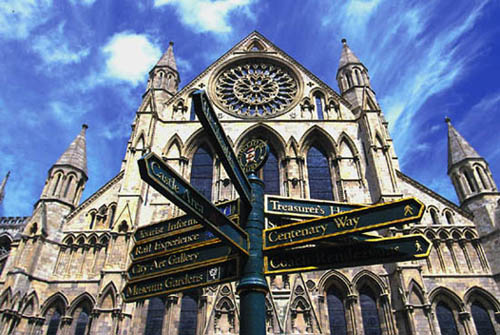
York Minster, the magnificent cathedral in the heart of York, takes its name from the old word "Minster", meaning "teaching or ministering". York Minster contains the Archbishop's throne or "cathedra". The present cathedral is the fourth on this site, the first dating back to the 7th century. The largest medieval structure in the United Kingdom and the largest Gothic cathedral in Northern Europe, the minster is truly awe-inspiring. Its construction commenced in 1220 under the auspices of Archbishop de Grey and the work was only completed in 1472. The Minster is a treasure trove of medieval carving and its 128 windows contain one of the most extensive collections of stained glass in existence, dating from the 12th century to the present day. The Great East Window is the largest stained glass window in the world.
The most destructive fire of modern times took place in 1829 when Mad Martin, a religious fanatic, set fire to part of the cathedral. More than a century later, in 1984, a lightning bolt struck York Minster, setting off a serious blaze.
To glean more of the history of York Minster, take the excellent audio tour of the Undercroft, Treasury and Crypt. For amazing views over the city, climb to the top of the Tower.
Streets, Bars, Gates and Walls
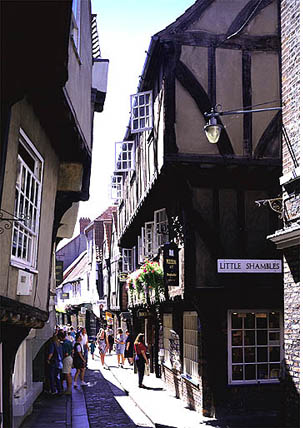 A number of York's streets have names ending in "gate", which was the Vikings' word for "street". However, Stonegate existed before the Viking period, having been the "Via Praetoria" to the main entrance of the Roman fortress. Today, Stonegate, a bustling shopping street, is kept free of traffic, so that one may marvel at its rich medieval and Georgian architecture, undisturbed by modern exhaust fumes.
A number of York's streets have names ending in "gate", which was the Vikings' word for "street". However, Stonegate existed before the Viking period, having been the "Via Praetoria" to the main entrance of the Roman fortress. Today, Stonegate, a bustling shopping street, is kept free of traffic, so that one may marvel at its rich medieval and Georgian architecture, undisturbed by modern exhaust fumes.
The Shambles is Britain's finest -- and most-photographed -- medieval street, where the buildings on opposite sides appear to be leaning towards each other, trying to touch. The Shambles is mentioned in the Domesday Book, so we know it dates back at least 900 years!
The Walls of York are a distinctive tourist attraction, dating back to Roman times. Fragments of the Roman walls remain, but it is the 3 miles of medieval walls, carefully maintained and restored, which now encircle the old city. For a bird's eye view of the surroundings, take a stroll along these Walls.
The earth ramparts on which the Walls stand were raised by the Romans and Anglo-Danish kings of York and strengthened by the Normans. Today, they are gaily decorated by daffodils -- a brilliant sight in Spring.
The Bars of York are another unique feature of the city walls. Gateways allowed entry, but bars barred your way. In past centuries, barring entry to a city was far more important than allowing it! Bootham Bar is the defensive bastion for the North Road. Monk Bar has a working portcullis, while Walmgate Bar is the only gateway in England to have preserved its barbican, a funnel-like approach to a city, which forced attackers to bunch together when invading a city.
Micklegate Bar is the South entrance and was -- and still is today -- traditionally the Monarch's entrance to the city. Less happily, Micklegate Bar is also the site where the heads of traitors were displayed.
Another "bar" worth visiting, is that of the York Brewery in Micklegate. Here one may go on a guided tour of York's independent brewery, where York beer is still brewed by traditional methods, and afterwards taste a pint of the best at the bar. The visitor is shown how the grist case is loaded, the fermentation process and other intricacies which go into the historic brewing process.
Clifford's Tower
Standing proudly on a high mound in the city walls, Clifford's Tower symbolizes York's turbulent history. Built by William the Conqueror as one of two mottes (mounds) with wooden keeps on top in order to secure the unruly North after his 1066 invasion, this impenetrable Tower was once the central stronghold of York Castle.
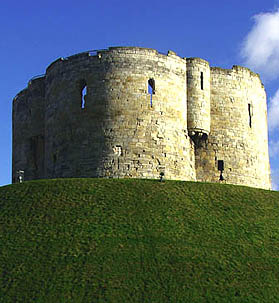 This same Tower was also the scene of one of York's most shameful and tragic past events. In 1190, the Jews of York sought refuge in the Tower after being attacked by a local mob. Surrounded by the angry mob, they were given the choice of being baptized or killed. They chose instead to commit mass suicide, setting the Tower (made of timber at that time) on fire. It burned to the ground. The few surviving Jews emerged the following day, only to be massacred by the besiegers. As punishment for this dreadful act, the King's Chancellor dismissed the sheriff and constable and imposed a heavy fine on the citizens of York. However, the ringleaders of the mob had fled and could not be brought to justice.
This same Tower was also the scene of one of York's most shameful and tragic past events. In 1190, the Jews of York sought refuge in the Tower after being attacked by a local mob. Surrounded by the angry mob, they were given the choice of being baptized or killed. They chose instead to commit mass suicide, setting the Tower (made of timber at that time) on fire. It burned to the ground. The few surviving Jews emerged the following day, only to be massacred by the besiegers. As punishment for this dreadful act, the King's Chancellor dismissed the sheriff and constable and imposed a heavy fine on the citizens of York. However, the ringleaders of the mob had fled and could not be brought to justice.
In the latter half of the 13th century, the keep was rebuilt in stone and given a quatrefoil plan of which there is no other example in England. For centuries this bastion, formerly known as "The King's Tower", played a key role in the control of England. It survived flood, fire and siege. In 1322, it became known as "Clifford's Tower", after the aristocratic traitor, Roger de Clifford, was hanged from its walls.
Right now, the people of York are fighting a 21st century battle. The City Council of York has given permission for a London-based developer to build "Coppergate II" -- a huge shopping complex -- on both sides of the River Foss, which would include building right up to Clifford's Tower. This intended modern construction is particularly opposed by the citizens as it could so easily be situated on the opposite banks of the river without encroaching on historic Clifford's Tower, the city's most famous landmark.
Halls and Houses
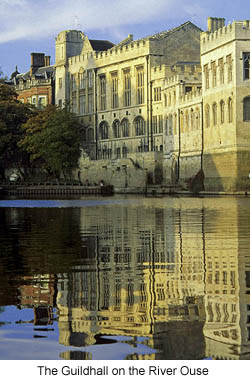 Two rivers meet in York, the Ouse and the Foss. The Ouse, at one time a tidal river, enabled York to become a great port and trading city. The 15th Century Guildhall on the banks of the Ouse, with its splendidly carved interior, was virtually destroyed in an air raid during the 2nd World War, but has since been expertly restored.
Two rivers meet in York, the Ouse and the Foss. The Ouse, at one time a tidal river, enabled York to become a great port and trading city. The 15th Century Guildhall on the banks of the Ouse, with its splendidly carved interior, was virtually destroyed in an air raid during the 2nd World War, but has since been expertly restored.
The Merchant Adventurers' Hall in Fossgate is Europe's finest medieval guildhall, built in 1357. It is here, in the magnificently timbered Great Hall, that merchants conducted their weighty business. Below is the Undercroft and Chapel, where the poor were cared for.
Mulberry Hall is situated a mere 200 yards from York Minster. This elegant Tudor mansion (once a private home) now contains 17 showrooms extending over three floors. Its exquisite wares include fine china by Wedgwood, Spode, Royal Crown Derby, Royal Worcester and Royal Doulton; porcelain by Royal Copenhagen, Herend and Meissen; crystal by Waterford, Baccarat, and Lalique; enamels by Halcyon Days and silver by George Jensen and Christofle.
Barley Hall, just off Stonegate, affords the visitor a hands-on experience. Here, in one of York's best preserved medieval townhouses, one may step back in time, handle medieval wares and try on the costumes of a bygone era.
York's Lord Mayor ranks only second to London's in the United Kingdom. His official residence, built in the 18th century, is an excellent example of Georgian architecture. The Mansion House is the only house in England which is used solely as an official private residence for a Lord Mayor during his term of office. It is here that York's city regalia and historic civic plate are kept.
The Treasurer's House was built on the site of the Roman legions' fortress and was the residence of York's treasurers until 1547. Subsequently, it had a succession of private owners and in 1720 was divided into Gray's Court and the present Treasurer's House. In 1930 it was left to the National Trust together with its fine collection of furnishings. Thirteen different rooms spanning four centuries wait to be explored in the Treasurer's House, as well as a guided tour of the ghostly cellar. There is free access to the art gallery, walled garden and tearoom.
A Surfeit of Museums
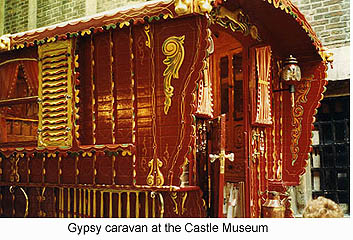 With over 30 museums, galleries and tours to choose from it is a difficult -- and virtually impossible -- task to fit everything in. Top of the list of museums in York, however, has to be York Castle Museum which provides an in-depth view of life in Victorian Britain. Here one can walk down cobbled streets and peer into the windows of Victorian shops. The actual prison cell where Dick Turpin spent his last night is also on display in the Castle Museum.
With over 30 museums, galleries and tours to choose from it is a difficult -- and virtually impossible -- task to fit everything in. Top of the list of museums in York, however, has to be York Castle Museum which provides an in-depth view of life in Victorian Britain. Here one can walk down cobbled streets and peer into the windows of Victorian shops. The actual prison cell where Dick Turpin spent his last night is also on display in the Castle Museum.
The Yorkshire Museum and Gardens is another of York's fascinating museums. Set in lovely botanic gardens within the center of the city, this museum houses some of Britain's finest Roman and Viking archaeological discoveries as well as renowned collections of fossils, pottery, jewels and spoils of war.
For the art lover, York Art Gallery on Exhibition Square close to York Minster contains superb collections of over 600 years of British and European art, from the time of the Wars of the Roses to the 21st century.
The advent of the railway in the 19th century marked the beginning of a new era of prosperity for York. York's National Railway Museum contains three huge galleries of interactive exhibits and working locomotive demonstrations, providing an interesting treat for the whole family. The Railway Museum boasts the only Bullet Train outside Japan and special daily events such as the locomotive turntable exhibition. Admission is free.
A tour of the Roman Bathhouse is an insight into how the Romans kept clean! The guided tour by a "legionnaire" commences at the bathhouse daily at 1 p.m.
The York Dungeon in Clifford Street gives the visitor an opportunity to relive York's less glorious past. "The York Dungeon is not recommended to those of a nervous disposition or young children" is a warning to be heeded by the visitor. The more gruesome aspects of York's past history, its horror and some of its humor are brought to life by actors and special sound and light effects.
A Viking Encounter
No visit to York would be complete without seeing Jorvik, the incredible reconstruction of a 1000-year old Viking city. Here, one comes face to face with York's Viking past in "the authentic Viking encounter".
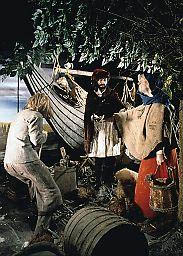 In the late 1970's, archaeologists uncovered the remains of a Viking city in Coppergate, right in the heart of York! Now one may visit this very site, journey through a reconstruction of Viking-age streets, get face-to-face with resident Vikings and view over 800 artifacts uncovered during excavations of the site. Jorvik offers a changing program of special exhibitions, events and educational lectures by archaeologists.
In the late 1970's, archaeologists uncovered the remains of a Viking city in Coppergate, right in the heart of York! Now one may visit this very site, journey through a reconstruction of Viking-age streets, get face-to-face with resident Vikings and view over 800 artifacts uncovered during excavations of the site. Jorvik offers a changing program of special exhibitions, events and educational lectures by archaeologists.
Jorvik is owned by the York Archaeological Trust which uncovered the Viking city. A variety of activities is included in the entrance fee to Jorvik, the highlight being a slow motorized journey through a reconstruction of the streets of Jorvik as archaeologists imagine them to have been.
During this incredible journey, one hears Viking voices and city sounds, smells the rather unsavory street smells and sees lifelike moving wax models of the inhabitants going about their daily routines.
Emerging from the dimly lit streets of Jorvik, one enters an exhibition hall of Viking handicrafts in progress by modern day inhabitants of York. The adjoining hall contains an absorbing display of hundreds of artifacts unearthed during the Jorvik excavations.
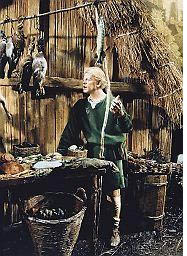 An adjacent exhibition conisists of 10th to 11th century skeletal remains, together with informative scientific and medical evidence providing enlightening new knowledge about the daily lives of the Vikings. A complete skeleton is the highlight of this exhibition. Archaeologists surmise that the skeleton is that of a young warrior, cut down in his prime by a blow to the skull and other fatal battle wounds.
An adjacent exhibition conisists of 10th to 11th century skeletal remains, together with informative scientific and medical evidence providing enlightening new knowledge about the daily lives of the Vikings. A complete skeleton is the highlight of this exhibition. Archaeologists surmise that the skeleton is that of a young warrior, cut down in his prime by a blow to the skull and other fatal battle wounds.
In the gift shop, Viking jewelry and replicas of artifacts are on sale, including Viking swords, shields, drinking horns, glassware and ceramics. In addition, a visit to the site of the Archaeological Resource Center at St. Saviour's Church in Saviourgate allows you to take "History in your hands", just as promised by their slogan. This educational center features work stations where you are able to handle genuine Viking and Roman artifacts. Every Summer one may observe a real archaeological dig in progress -- for the Jorvik excavations are far from complete and many more exciting discoveries are expected in the near future! A visit to the ARC is suitable for the whole family, including wheelchair users. The Sensory Garden features hearing posts, Braille, large text and wheelchair access. The plants in this Garden provide clues as to the historic use of herbs in medicine and cooking. Income generated by the ARC enables the Trust to fund further archaeological activity, excavation and research.
Getting Around
York has the dubious title of "Europe's most haunted city" so, as night falls, you may choose to go on one of the many guided Ghost Walks. The Ghost Walk is a professional artistic production, a thought-provoking journey into the darker side of York's past, recommended for the brave of heart only! (For more information, see The Ghosts of York.)
A week or more is needed merely to scratch at the surface of what this historic city has to offer! However, if you are pressed for time, York tourism offers a wonderful "Hop on -- Hop Off" bus service, which entitles passengers to hop on and off the distinctive red open-top buses at 20 of the most important historical sites within the city. These stops include Clifford's Tower, Monk Bar, Walmgate Bar, Mickelgate Bar, York Minster, The Shambles, Merchant Adventurers' Hall, Castle Museum, Jorvik and the National Railway Museum. An interesting recorded commentary accompanies the tour. The ticket is valid for 24 hours. This comprehensive bus tour is a convenient way of sightseeing in an ancient city where driving is hair-raising and costly parking spaces virtually impossible to find!
Another relaxing means of taking in the sights of York from a different perspective is the York Boat, a 1-hour guided river trip with Captain's commentary. The York Boat leaves from the Boatyard at Lendal Bridge for day and evening cruises.
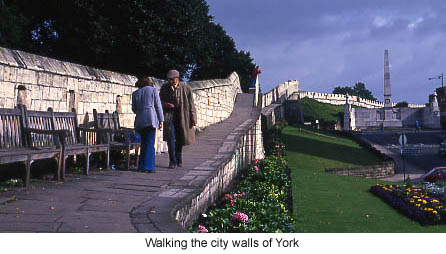
For the more energetic, guided walks on historic themes are conducted daily between February and November and in weekends between January and December, starting at the Museum Garden Gates.
The Flying Eye helicopter flight provides a fantastic aerial view of the historical center of York and the surrounding countryside, including the Yorkshire Dales and East Coast.
If travelling to York by car, it is advisable to park your car at one of York's Park and Rides and to travel by bus to the center. The Park and Drives are situated all around the city. The nominal fee includes 24-hour parking and a hassle-free return bus ride into the city center.
The York Pass is excellent value for money, allowing entrance to more than 30 attractions, including discounts at restaurants, evening entertainment and certain shops. The York Pass is available for 1, 2 or 3 days and comes with a free color guide book in English, French and German. It may be purchased from the York Tourist Offices or over the Internet.
There are few other cities which cater so much to the visitor as does York. The York Tourist Board simply can not do enough to promote tourism in its city, of which it is so justly proud. The friendly Tourist Office staff provide free brochures, maps and information of every description, including advice on and the reservation of accommodation, with over 250 properties ranging from upmarket hotels to small family-run guest houses, hostels and camping facilities from which to choose.
Beyond the City
If you are fortunate enough to have time to spare, the surrounding Yorkshire countryside has much to offer. Castle Howard is an 18th century mansion in a stunning setting of parkland dotted with temples, lakes and fountains.
The tranquil ruins of Fountains Abbey, with its nearby monastic watermill is a World Heritage site, well worth a visit. (For more information, see The Lingering Power of Fountains Abbey, by Julia Hickey.)
For animal lovers and fans of the popular vet-author, "The World of James Herriot" is a must-see in the nearby town of Thirsk. James Herriot's original house as it was in the 1940's has been recreated and includes three rooms dedicated to the history of veterinary medicine. A virtual farm with life size model animals ensures an outing with a difference.
There is no other city in the world -- nay, not even in England! -- where one may "live the history" so vibrantly as in York. If you visit no other city in England, do visit York!
Related Articles:
- Where Emperors, Kings and Saints Have Walked: York Minster, by Julia Hickey
- https://www.timetravel-britain.com/articles/churches/minster.shtml
- Jorvik: The Viking City of York, by Brenda Ralph Lewis
- https://www.timetravel-britain.com/articles/towns/jorvik.shtml
- York Timeline
- https://www.timetravel-britain.com/articles/towns/yorktime.shtml
- The Ghosts of York, by Jillian Schedneck
- https://www.timetravel-britain.com/articles/history/ghosts.shtml
- A Taste of Yorkshire: Yorkshire Pudding, Parkin and Pomfret Cakes, by Dawn Copeman
- https://www.timetravel-britain.com/articles/taste/taste02.shtml
- Uncovering the Archaeological Bounty of York, by Sara Polsky
- https://www.timetravel-britain.com/articles/towns/yorkdig.shtml by Sara Polsky
More Information:
We regret that we no longer have the resources to maintain up-to-date links and/or hours and pricing details for the various sites and attractions listed on this website. For more information about the location(s) listed above, please use your favorite search engine or visit Wikipedia.
Pearl Harris, whose ancestors hail from Britain, was born in South Africa. In 2002, she emigrated to the Czech Republic with her husband, their dog and cat. Pearl resides permanently in the Czech Republic where she works as a freelance travel writer, English teacher and proof-reader. Her main passion is travel. Having traveled extensively in Africa, Europe,the USA and UK, she never intends to stop. Other interests are pets, photography, reading and writing. Pearl, a retired Diagnostic Radiographer, has a B.A. in English and Linguistics, post-graduate Diploma in Translation and TEFL qualification. Her only daughter, a professional photographer, lives in New Orleans.
Article © 2005 Pearl Harris
Photos courtesy of http://www.visityork.org
Gypsy caravan and city wall photos © Moira Allen
|
